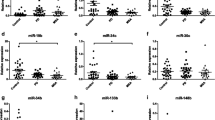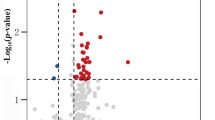Abstract
Multiple system atrophy (MSA) is a neurodegenerative disease that belongs to the α synucleinopathies. Clinically, there is an overlap between MSA and Parkinson’s disease (PD), especially at the early disease stage. However, these two pathologies differ in terms of disease progression. Currently, no biomarker exists to differentiate MSA from PD. MicroRNAs are non-coding RNAs implicated in gene expression regulation. MiRNAs modulate cellular activity and they control a range of physiological and pathological functions. miRNAs are found in biofluids, such as blood, serum, plasma, saliva, and cerebrospinal fluid. Many groups, including ours, found that circulating miRNAs are differently expressed in blood, plasma, serum and cerebrospinal fluid of PD and MSA patients. In the present study, our primary aim was to determine if serum mir-30-5p and mir-148b-5p can be used as biomarkers for early diagnosis of PD and/or MSA. Our secondary goal was to determine if serum levels of those miRNAs can be correlated with the patients’ clinical profile. Using quantitative PCR (qPCR), we evaluated expression levels of miR-30c-5p and miR148b-5p in serum samples from PD (n = 56), MSA (n = 49), and healthy control (n = 50) subjects. We have found that miR-30c-5p is significantly upregulated in MSA if compared with PD and healthy control subjects. Moreover, serum miR-30c-5p levels correlate with disease duration in both MSA and PD. No significant difference was found in miR-148b-5p among MSA, PD and healthy control subjects. Our results suggest a possible role of serum miR-30-5p as a biomarker for diagnosis and progression of MSA.



Similar content being viewed by others
References
Brai E et al (2016) Notch1 hallmarks fibrillary depositions in sporadic Alzheimer’s disease. Acta Neuropathol Commun 4(1):64
Cardo LF et al (2013) Profile of microRNAs in the plasma of Parkinson’s disease patients and healthy controls. J Neurol 260(5):1420–1422
Choubey V et al (2014) BECN1 is involved in the initiation of mitophagy: it facilitates PARK2 translocation to mitochondria. Autophagy 10(6):1105–1119
De Smaele E, Ferretti E, Gulino A (2010) MicroRNAs as biomarkers for CNS cancer and other disorders. Brain Res 1338:100–111
Desplats P et al (2011) α-Synuclein sequesters Dnmt1 from the nucleus: a novel mechanism for epigenetic alterations in Lewy body diseases. J Biol Chem 286(11):9031–9037
Galvin JE, Lee VM, Trojanowski JQ (2001) Synucleinopathies: clinical and pathological implications. Arch Neurol 58:186–190
Grasso M, Piscopo P, Confaloni A, Denti MA (2014) Circulating miRNAs as biomarkers for neurodegenerative disorders. Molecules 19(5):6891–6910
Hossein-nezhad A et al (2016) Transcriptomic profiling of extracellular RNAs present in cerebrospinal fluid identifies differentially expressed transcripts in Parkinson’s disease. J Parkinson’s Dis 6(1):109–117
Jankovic J, Tolosa E (eds) (1998) Parkinson’s disease movement disorders, vol 8, pp 159–171
Khoo SK et al (2012) Plasma-based circulating microRNA biomarkers for Parkinson’s disease. J Parkinson’s Dis 2(4):321–331. 12
Kume K et al (2018) Serum microRNA expression profiling in patients with multiple system atrophy. Mol Med Rep 17(1):852–860
Laurens B et al (2015) Fluid biomarkers in multiple system atrophy: a review of the MSA biomarker initiative. Neurobiol Dis 80:29–41
Marques TM et al (2017) MicroRNAs in cerebrospinal fluid as potential biomarkers for Parkinson’s disease and multiple system atrophy. Mol Neurobiol 54(10):7736–7745
Merwe et al (2015) Evidence for a common biological pathway linking three Parkinson’s disease causing genes: parkin, PINK1 and DJ1. Eur J Neurosci 41(9):1113–1125
Michiorri S et al (2010) The Parkinson-associated protein PINK1 interacts with Beclin1 and promotes autophagy. Cell Death Differ 17(6):962–974
Nadim WD et al (2017) MicroRNAs in neurocognitive dysfunctions: new molecular targets for pharmacological treatments? Curr Neuropharmacol 15(2):260–275
Pickford F et al (2008) The autophagy-related protein beclin 1 shows reduced expression in early Alzheimer disease and regulates amyloid β accumulation in mice. J Clin Invest 118(6):2190
Quévillon Huberdeau M, Simard MJ (2018) A guide to microRNA-mediated gene silencing. FEBS J. https://doi.org/10.1111/febs.14666
Serpente M et al (2015) Profiling of ubiquitination pathway genes in peripheral cells from patients with frontotemporal dementia due to C9ORF72 and GRN mutations. Int J Mol Sci 16(1):1385–1394
Son JH et al (2012) Neuronal autophagy and neurodegenerative diseases. Exp Mol Med 44(2):89–98
Song C et al (2011) Paraquat induces epigenetic changes by promoting histone acetylation in cell culture models of dopaminergic degeneration. Neurotoxicology 32(5):586–595
Vallelunga A et al (2014) Identification of circulating microRNAs for the differential diagnosis of Parkinson’s disease and multiple system atrophy. Front Cell Neurosci 8:156
Wang JD et al (2015) A pivotal role of FOS-mediated BECN1/Beclin 1 upregulation in dopamine D2 and D3 receptor agonistinduced autophagy activation. Autophagy 11(11):2057–2073
Wenning GK et al (1994) Clinical features and natural history of multiple system atrophy: an analysis of 100 cases. Brain 117:835–845
Wu Q et al (2017) Nuclear accumulation of histone deacetylase 4 (HDAC4) exerts neurotoxicity in models of Parkinson’s disease. Mol Neurobiol 54(9):6970–6983
Yoon JH et al (2017) Parkin mediates neuroprotection through activation of Notch1 signaling. Neuroreport 28(4):181–186
Author information
Authors and Affiliations
Corresponding author
Ethics declarations
Conflict of interest
The authors declare that they have no known conflicts of interest in relation to this article.
Additional information
Publisher’s Note
Springer Nature remains neutral with regard to jurisdictional claims in published maps and institutional affiliations.
Rights and permissions
About this article
Cite this article
Vallelunga, A., Iannitti, T., Dati, G. et al. Serum miR-30c-5p is a potential biomarker for multiple system atrophy. Mol Biol Rep 46, 1661–1666 (2019). https://doi.org/10.1007/s11033-019-04614-z
Received:
Accepted:
Published:
Issue Date:
DOI: https://doi.org/10.1007/s11033-019-04614-z




